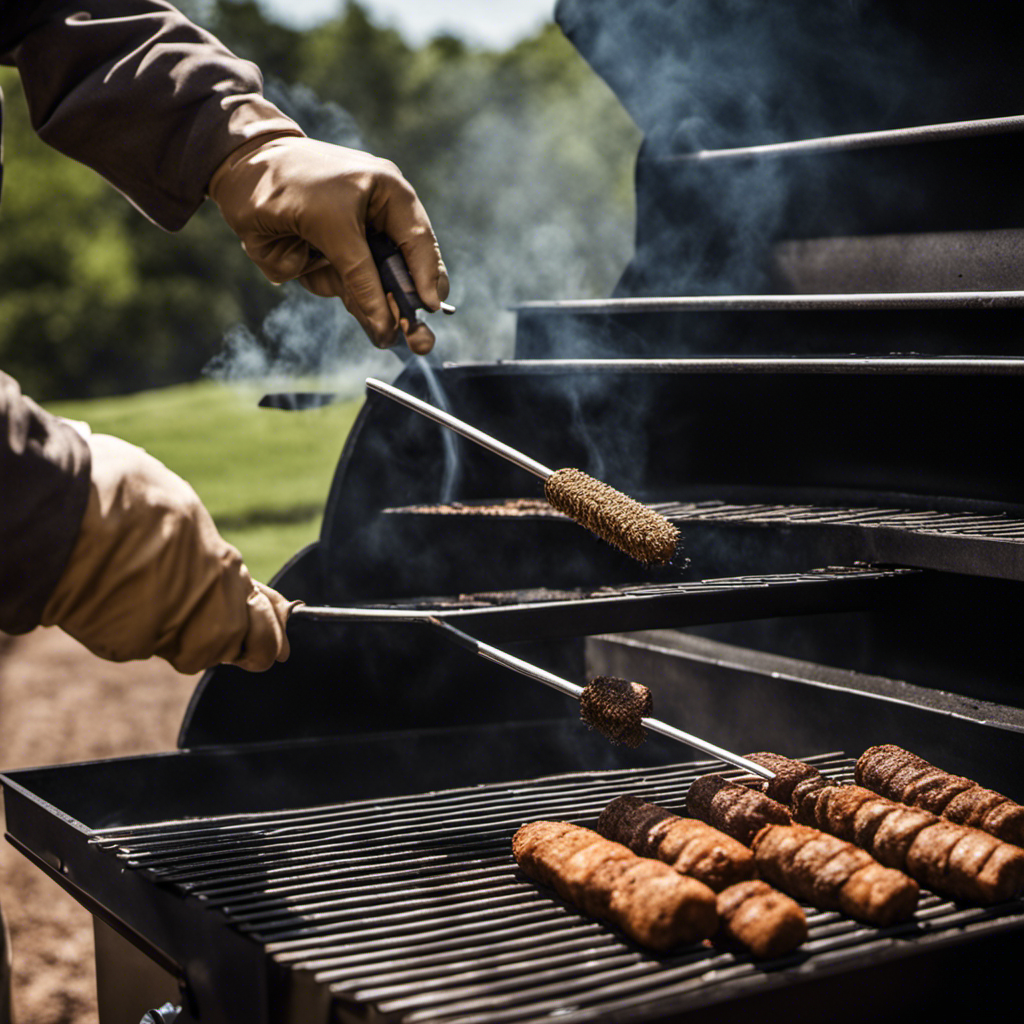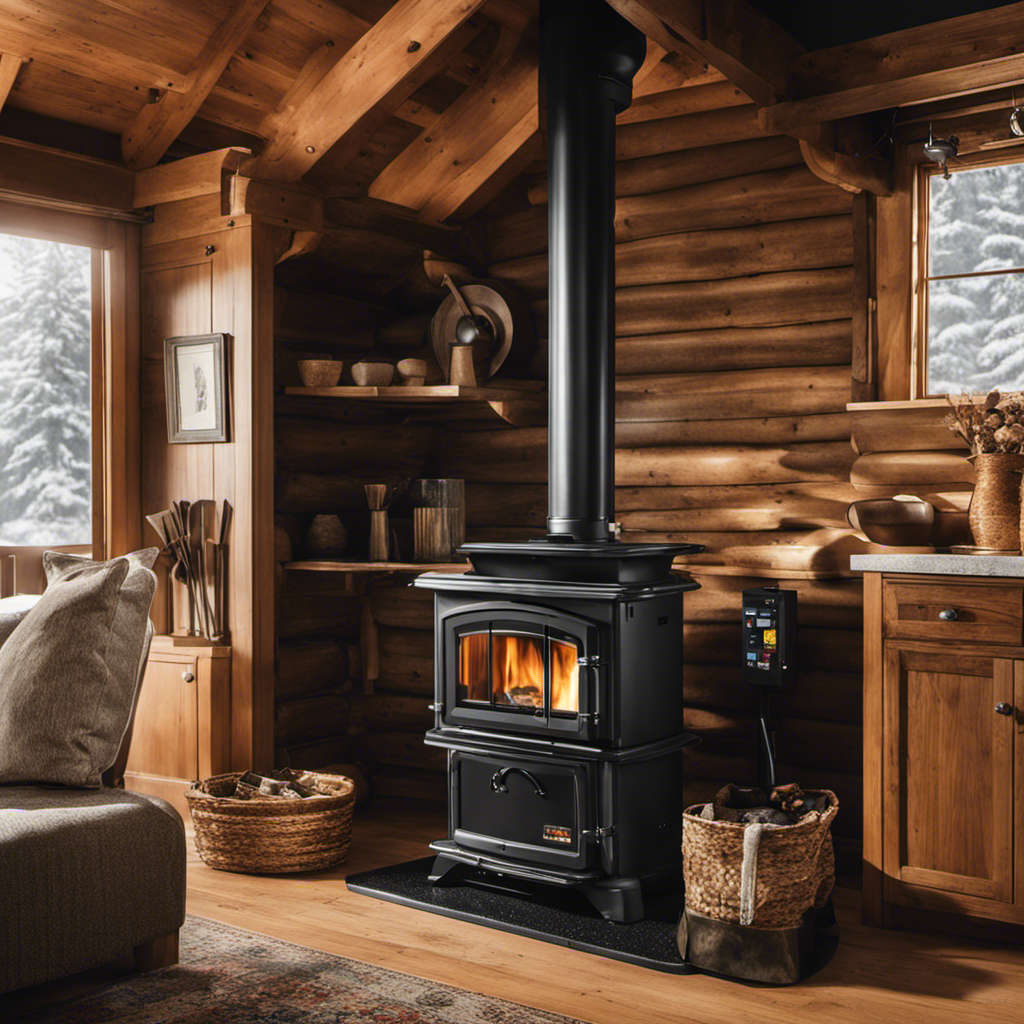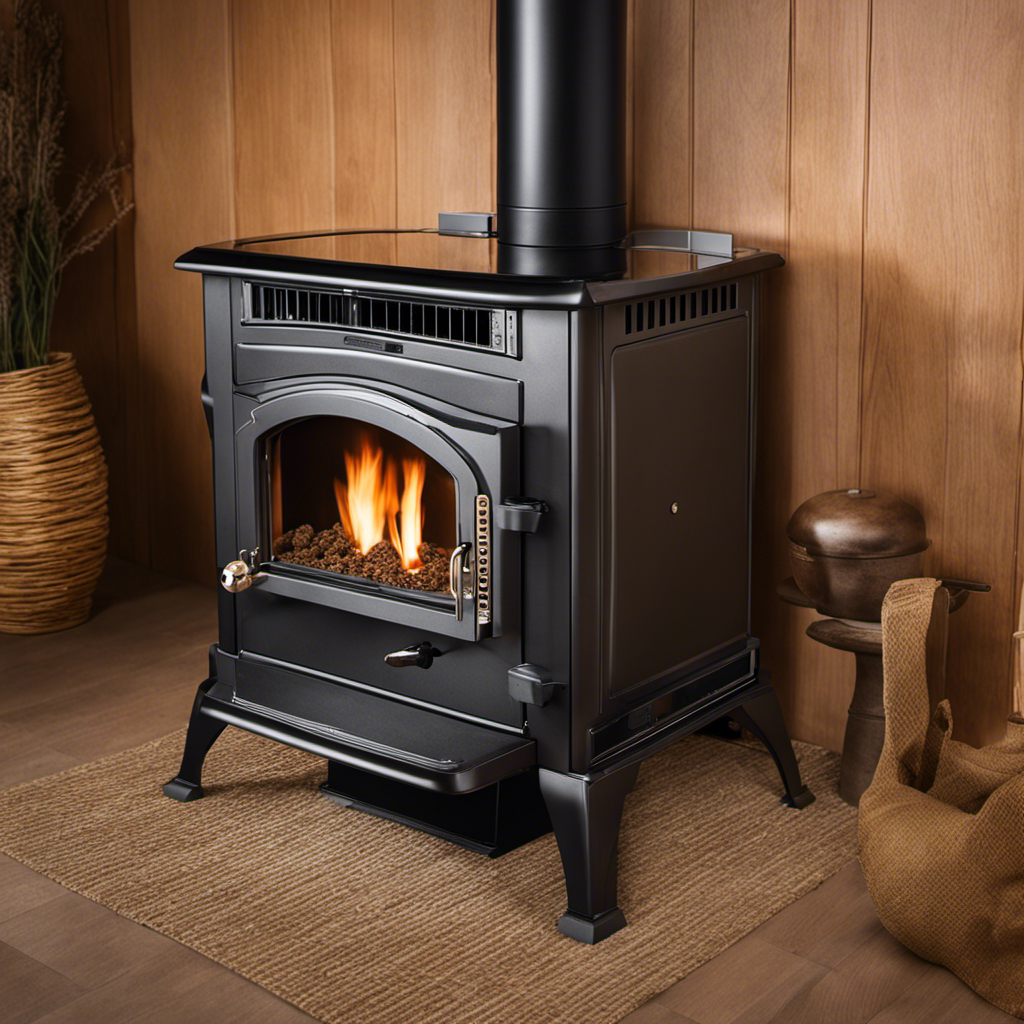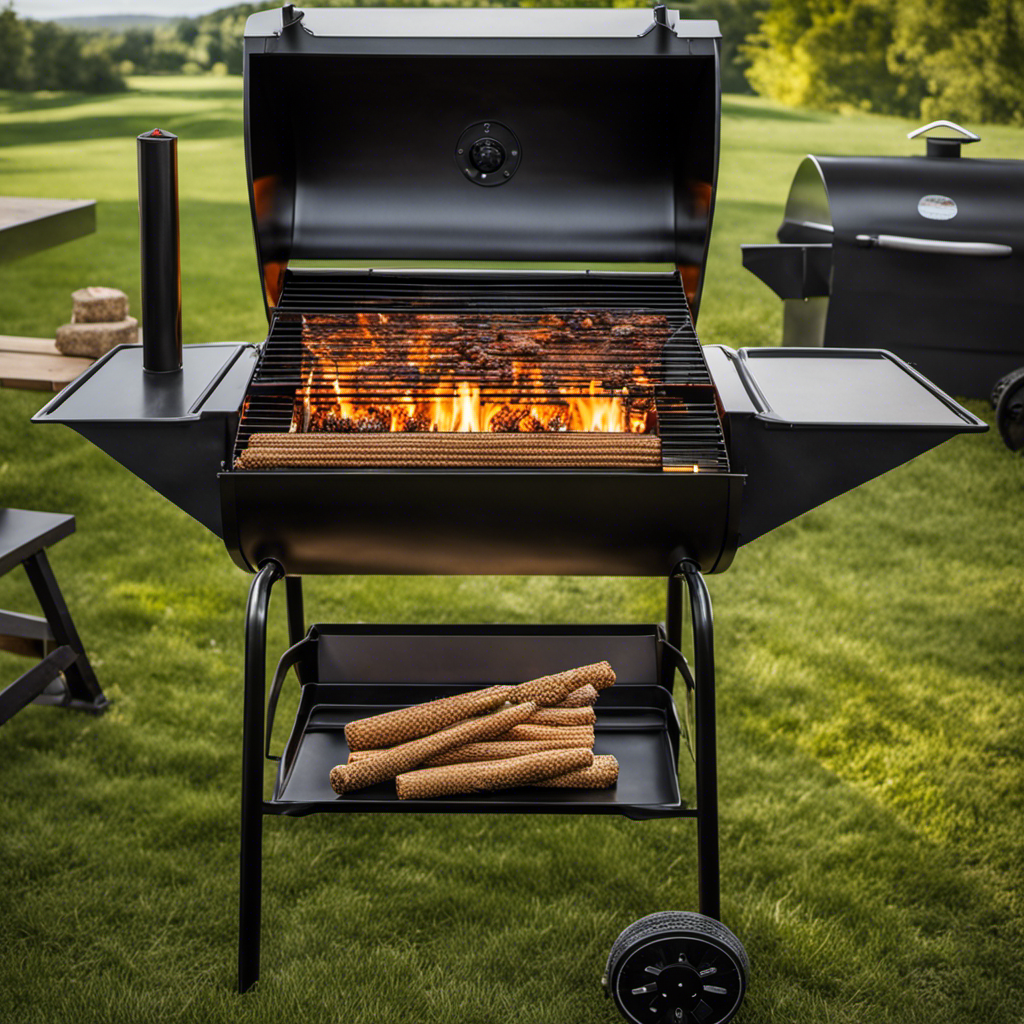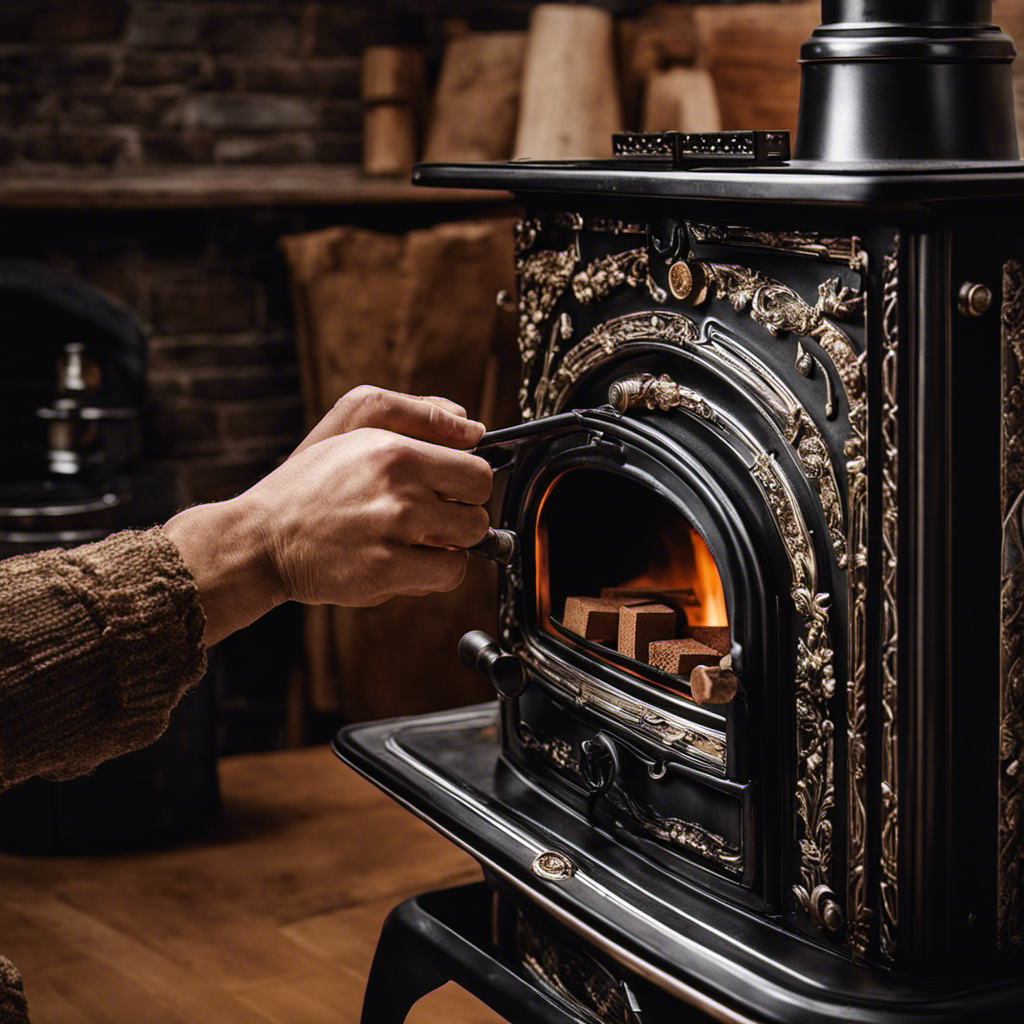As I stand in front of my trusty wood pellet grill, I can’t help but swell with pride. This faithful friend has been the source of numerous delicious dishes, and now it’s time to give it some well-deserved maintenance.
In this article, I’ll guide you through the art of cleaning a wood pellet grill. From removing and cleaning the grease tray to scrubbing the grill grates, we’ll leave no crevice untouched.
So, let’s roll up our sleeves and give our beloved grill the attention it deserves.
Key Takeaways
- Ensure the grill has cooled down completely before cleaning.
- Use a grill brush to scrape off excess debris from the inside of the grill.
- Regularly clean the grease tray to maintain optimal performance.
- Clean the grill grates after each use to prevent buildup and maintain optimal grilling conditions.
Preparing the Grill for Cleaning
Before you start cleaning, make sure the grill has completely cooled down. This is an important safety precaution to avoid any burns or accidents.
Once the grill is cool, there are a few pre-cleaning steps you should take. First, remove the grill grates and set them aside. Then, using a grill brush, scrape off any excess debris or food particles from the inside of the grill.
After that, it’s time to gather the necessary cleaning products. I recommend using a mild dish soap, warm water, and a sponge or cloth for general cleaning. For tougher stains or grease buildup, you may need a specialized grill cleaner or degreaser.
Now, let’s move on to the next section about removing and cleaning the grease tray.
Removing and Cleaning the Grease Tray
Maintaining the grease tray of your grill is essential for ensuring its optimal performance and longevity.
In order to keep your grease tray in top shape, it is important to regularly clean it and remove any accumulated grease or debris.
Additionally, proper grease disposal is crucial for environmental safety, so be sure to follow the appropriate guidelines for disposing of grease waste.
Grease Tray Maintenance Tips
To prevent grease buildup in your wood pellet grill, make sure you regularly empty and clean the grease tray. Proper grease tray maintenance is essential for the longevity and performance of your grill. Here are some cleaning techniques to keep your grease tray in top shape:
| Cleaning Technique | Steps |
|---|---|
| Scrubbing | Use a brush or sponge to scrub away any grease or residue from the tray. |
| Hot Soapy Water | Fill a basin with hot soapy water and soak the tray for a few minutes. Scrub again to remove stubborn grease. |
| Vinegar Solution | Mix equal parts of vinegar and water, and use it to clean the tray. Vinegar helps to break down grease effectively. |
Regularly inspect the grease tray for any damage or signs of wear and tear. If necessary, replace the tray to ensure proper functioning of your grill. Once you’ve cleaned the grease tray, it’s important to dispose of the grease properly.
Proper Grease Disposal
Once you’ve finished cooking, make sure to properly dispose of the grease from the grease tray. Grease disposal is an important part of maintaining your wood pellet grill and preventing grease buildup.
There are a few techniques you can use to safely dispose of the grease. One option is to wait for the grease to cool and solidify, then scrape it into a sealable container and throw it in the trash. Another option is to pour the cooled grease into a jar or bottle and seal it tightly before discarding.
Never pour grease down the sink or toilet, as it can clog the pipes. Properly disposing of grease will help keep your grill functioning optimally.
Now, let’s move on to cleaning the grill grates.
Cleaning the Grill Grates
When it comes to cleaning the grill grates, there are a few key points to keep in mind.
First, it’s important to remove any grease and residue that may have accumulated on the grates. This can be done using a grill brush or scraper, depending on the level of buildup.
Secondly, selecting the proper brush is essential for effective cleaning. A wire brush with sturdy bristles is ideal for removing tough residue, while a brass brush is gentler and better suited for regular maintenance.
Lastly, it’s recommended to clean the grill grates after each use to prevent buildup and maintain optimal grilling conditions.
Removing Grease and Residue
Cleaning a wood pellet grill involves using a degreaser to remove grease and residue. To effectively clean the grill, it is important to choose the right cleaning products and utilize proper degreasing techniques. When selecting a degreaser, opt for one that is specifically designed for grills and safe to use on wood pellet grills. This will ensure that the degreaser effectively breaks down grease and residue without damaging the grill’s surface. To help you understand the process better, here is a table outlining some popular cleaning products and their degreasing abilities:
| Product | Degreasing Ability |
|---|---|
| Citrus Degreaser | Excellent |
| Oven Cleaner | Good |
| All-Purpose Cleaner | Moderate |
| Dish Soap | Mild |
| Vinegar and Water Solution | Mild |
Now that you know which products to use, let’s move on to the next step – proper brush selection.
Proper Brush Selection
To effectively clean a wood pellet grill, it’s crucial to choose the right brush for the job. When it comes to proper brush care, it’s important to select a brush with sturdy bristles that can effectively remove grease and residue without scratching the grill’s surface. Look for a brush specifically designed for cleaning grills, preferably one with stainless steel or brass bristles. These materials are durable and can withstand the high heat of the grill. Avoid using brushes with nylon bristles, as they can melt and leave behind dangerous particles.
Additionally, consider alternative cleaning methods such as using aluminum foil or vinegar solutions for tougher stains. By taking care of your brush and choosing the right one, you can ensure a thorough and efficient cleaning process.
When it comes to cleaning frequency recommendations…
Cleaning Frequency Recommendations
Make sure you establish a regular cleaning schedule for your grill to prevent buildup and maintain its performance. Cleaning frequency will depend on how often you use your wood pellet grill, but a general recommendation is to clean it thoroughly every 5-10 uses. This will help remove any grease, ash, and debris that can accumulate over time.
When it comes to cleaning products, it is important to use ones that are specifically designed for wood pellet grills. Look for cleaners that are non-toxic and safe for use on stainless steel surfaces. These cleaners will effectively remove grease and grime without causing any damage.
Now that you know how often to clean your grill and what cleaning products to use, let’s move on to the next step: cleaning the fire pot and burn pot.
Cleaning the Fire Pot and Burn Pot
Start by removing any leftover ashes from the fire pot and burn pot. This is an important step in fire pot maintenance and ensures optimal performance of your wood pellet grill. Here are three techniques to clean the fire pot and burn pot effectively:
-
Use a vacuum cleaner with a brush attachment to remove any loose debris and ash from the fire pot and burn pot. This will help prevent clogs and ensure proper airflow.
-
Scrub the surfaces of the fire pot and burn pot with a wire brush or grill brush to remove any stubborn buildup. Be sure to wear protective gloves and goggles for safety.
-
Finish by wiping down the fire pot and burn pot with a damp cloth to remove any remaining residue. This will leave them clean and ready for your next grilling session.
Now that the fire pot and burn pot are spotless, let’s move on to cleaning the auger and pellet hopper.
Cleaning the Auger and Pellet Hopper
Once you’ve finished wiping down the fire pot and burn pot, it’s time to tackle cleaning the auger and pellet hopper.
The auger is responsible for transporting the pellets from the hopper to the fire pot, so it’s important to keep it clean and functioning properly.
Start by disconnecting the power and removing any remaining pellets from the hopper. Then, use a vacuum or brush to remove any debris or ash from the auger.
Be sure to also clean the ash tray located at the bottom of the hopper. This will prevent any buildup that could potentially cause clogs or other issues.
If you encounter any problems with the pellet hopper, such as pellets not feeding properly, be sure to troubleshoot by checking for any blockages in the auger or hopper.
With the auger and pellet hopper clean and in good working condition, you can move on to the next section on exterior cleaning and maintenance.
Exterior Cleaning and Maintenance
Now that we have cleaned the auger and pellet hopper, let’s move on to the exterior of the wood pellet grill. It’s important to keep the outside of your grill clean and well-maintained to ensure its longevity and preserve its appearance. Here are some effective exterior cleaning techniques to protect the wood finish:
-
Gentle Soap and Water: Mix a mild detergent with warm water and use a soft cloth or sponge to wipe down the exterior surfaces. Be sure to rinse thoroughly and dry with a clean cloth.
-
Vinegar Solution: Create a mixture of equal parts white vinegar and water. Apply it to the surface using a spray bottle or a cloth. Wipe away any dirt or grime, then rinse and dry.
-
Wood Protectant: Apply a wood protectant specifically designed for outdoor use to protect the wood finish from UV rays, moisture, and mold growth. Follow the manufacturer’s instructions for application.
Frequently Asked Questions
How Often Should I Clean My Wood Pellet Grill?
I clean my wood pellet grill at least once a month to keep it in good condition. Regular cleaning helps maintain the temperature and ensures efficient cooking. It’s important to follow the manufacturer’s instructions for proper cleaning procedures.
Can I Use Regular Household Cleaning Products to Clean My Wood Pellet Grill?
Using regular household cleaning products on a wood pellet grill may not be effective or safe. It’s important to clean the fire pot and burn pot regularly for proper functioning and to ensure a great grilling experience.
Is It Necessary to Clean the Fire Pot and Burn Pot of the Grill?
Yes, it is necessary to clean the fire pot and burn pot of the grill. Regular maintenance is important for wood pellet grills. Here are some cleaning tips for other parts of the grill.
What Should I Do if There Is Stubborn Grease or Residue on the Grill Grates?
If there’s stubborn grease or residue on the grill grates, the best cleaning method is to use a wire brush and hot soapy water. Scrubbing in a circular motion helps remove tough stains effectively.
How Do I Prevent Rust on the Exterior of My Wood Pellet Grill?
To prevent rust on the exterior of my wood pellet grill, I make sure to regularly clean and dry it after each use. This helps remove any moisture that can lead to rust, ensuring the longevity of my grill.
Can I Use the Same Cleaning Method for a DIY Wood Pellet Grill as a Store-Bought One?
When considering cleaning methods for a wood pellet grill, whether it’s homemade or store-bought, it’s crucial to follow a specific wood pellet grill construction tutorial. This will ensure that you effectively clean and maintain the grill, keeping it in top working condition for delicious barbecue every time.
Conclusion
In conclusion, cleaning a wood pellet grill is essential for its proper functioning and longevity. By following the steps outlined in this article, you can easily maintain a clean and well-maintained grill.
Some may argue that cleaning a grill is time-consuming, but the benefits far outweigh the effort. Just imagine enjoying perfectly grilled food without any residue or grease buildup. It’s like having a brand-new grill every time you cook.
So, grab your cleaning supplies and get ready to give your wood pellet grill the TLC it deserves.

